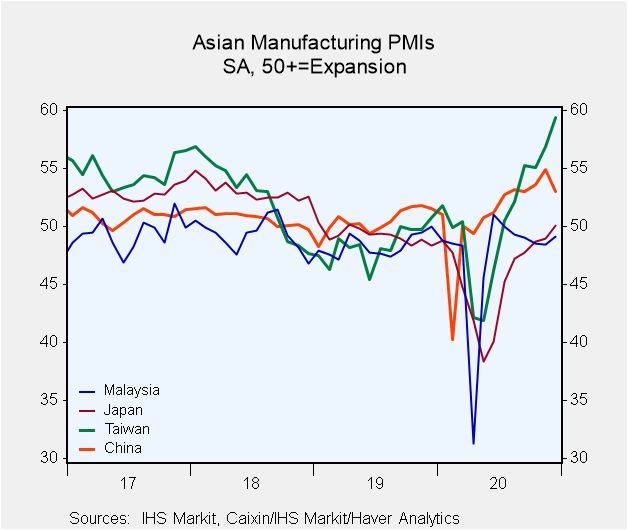 Global| Jan 04 2021
Global| Jan 04 2021Asian PMIs Rebound
Summary
Early reporting Asia economies show that manufacturing PMIs are recovering. In December, the seven early reporters show only Malaysia with a PMI gauge below 50 indicating manufacturing sector contraction. And Malaysia at 49.1 has a [...]
 Early reporting Asia economies show that manufacturing PMIs are recovering. In December, the seven early reporters show only Malaysia with a PMI gauge below 50 indicating manufacturing sector contraction. And Malaysia at 49.1 has a minor contraction signal at that. Also only China shows month-to-month backtracking as its index falls to 51.9 from 52.1 month-to-month. South Korea is unchanged month-to-month. In November three economies weakened month-to-month and three were indicating manufacturing contraction. There has been a steady improvement monthly from October to November to December.
Early reporting Asia economies show that manufacturing PMIs are recovering. In December, the seven early reporters show only Malaysia with a PMI gauge below 50 indicating manufacturing sector contraction. And Malaysia at 49.1 has a minor contraction signal at that. Also only China shows month-to-month backtracking as its index falls to 51.9 from 52.1 month-to-month. South Korea is unchanged month-to-month. In November three economies weakened month-to-month and three were indicating manufacturing contraction. There has been a steady improvement monthly from October to November to December.
The three-month averages show three countries below 50 indicating contracting activity, but only Malaysia weakens over three months compared to six months on average. The six-month averages are below 50 for five of the seven reporters, but that is an improvement from the 12-month averages where they all are below 50 indicating contraction.
On data ranked back to 2016, four of the manufacturing indexes have standings in their 80th to 90th percentiles. Japan and Vietnam are the weak respondents with readings below their 50th percentile. Malaysia has a moderate 61.7 percentile standing.
As we transition from 2020 to 2021 (not quite yet in this data set, but in real time), the virus has become an extremely important issue in 2021. The virus appeared then ebbed then surged again throughout 2020. But as 2020 ends and 2021 begins, there is a clear reinfection wave in progress globally. It may be in part piggy-backing on the end of year holiday season with spread encouraged by family gatherings even though those gatherings were discouraged.
Japan is considering calling a state of emergency. In Europe, the U.K.'s outbreak is so bad that it is trying to break with science to give more people a first inoculation at the risk of delaying the second one, which would leave it with an inoculation protocol that is untested and whose impact is unknown.
2021 is a new year. But while the calendar makes a clear break, everything else from 2020 continues to flow into 2021. Problems from the year before unfortunately do not just go away. They have not simply lingered but early in the year they are magnifying. But there are vaccines that could bring the virus under control. The existence of the vaccines and their ongoing deployment is the main event that makes 2021and its prospects much different and much brighter than 2020.
Robert Brusca
AuthorMore in Author Profile »Robert A. Brusca is Chief Economist of Fact and Opinion Economics, a consulting firm he founded in Manhattan. He has been an economist on Wall Street for over 25 years. He has visited central banking and large institutional clients in over 30 countries in his career as an economist. Mr. Brusca was a Divisional Research Chief at the Federal Reserve Bank of NY (Chief of the International Financial markets Division), a Fed Watcher at Irving Trust and Chief Economist at Nikko Securities International. He is widely quoted and appears in various media. Mr. Brusca holds an MA and Ph.D. in economics from Michigan State University and a BA in Economics from the University of Michigan. His research pursues his strong interests in non aligned policy economics as well as international economics. FAO Economics’ research targets investors to assist them in making better investment decisions in stocks, bonds and in a variety of international assets. The company does not manage money and has no conflicts in giving economic advice.






